Many modern dachas and country houses are no worse than city apartments in terms of comfort. To solve withdrawal problems Wastewater it is recommended to install autonomous sewers, what it is, few people know, but this concept is encountered more and more often.
Not every suburban village has the opportunity to connect to the central sewerage system, so comfortable living in the house is in question. In order not to give up the usual amenities, you can install an autonomous sewer system. There are several ways to arrange it, so it is important to make the right choice.
Conclusion of treated effluents to the reservoir
Few people know how to choose the right installation, and which sewerage scheme is better to use for a particular type of site, so you should heed the advice of professionals.
The main technical characteristics of autonomous sewers
A mandatory parameter is the performance of the equipment, it indicates the maximum volume of wastewater processed per day.
Such an indicator as a volley discharge indicates the discharge of wastewater in two hours without the risk of a system breakdown.
Also an important parameter is the depth of the tie-in, which indicates the maximum depth of laying the inlet sewer pipe.
The service period of maintenance, during which sludge is removed from the equipment, is also taken into account.
The quality of wastewater treatment from impurities plays an important role, while regulatory indicators are taken into account. Typically, in autonomous sewers, this figure is 98%.
For the manufacture of the case, different materials can be used, which will have certain advantages and disadvantages.
Ease of use is due to the presence of self-service systems.
Ease of installation, you can significantly save on installation costs.
Reliable operation of the system will depend on the level of complexity of the unit design, the number of service activities and fault tolerance.
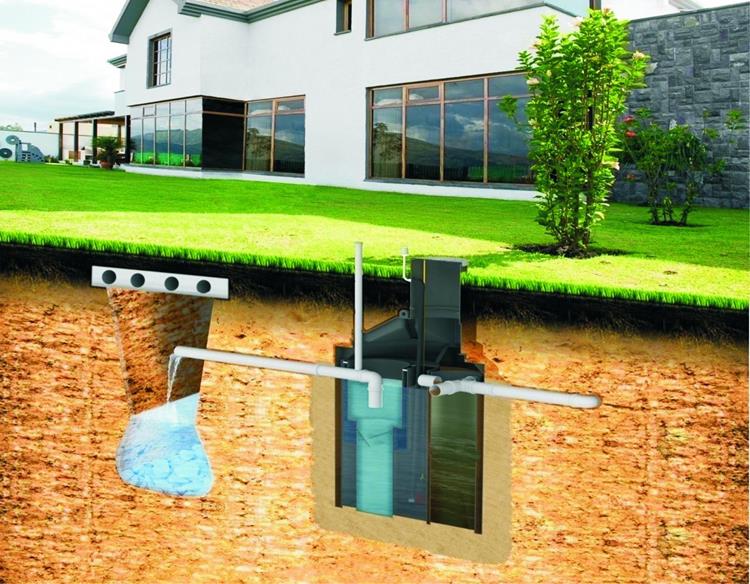 principle of operation of the sewage treatment system
principle of operation of the sewage treatment system As statistics show, Topas 5, Eurobion, Astra 5, Biodeka and Biopurit systems for the installation of suburban sewage are in great demand.
The disadvantages of autonomous units for wastewater treatment include a relatively high cost, which cannot be said about simple septic devices. Of course, if we take into account that in other cases frequent cleaning of structures with sewage trucks is required, then these costs will be justified, while the hassle will be much less.
Ways to install autonomous sewers
Modern autonomous sewage can be installed in several ways. Before choosing the appropriate option, you need to ask what types of installations for output and wastewater treatment are. Thus, several models of interest can be compared.
So, there are several ways to arrange a suburban sewage system:
- the simplest method is cesspool. Despite this, it does not meet many environmental requirements. This option is in most cases applicable to small suburban areas where people live intermittently;
- installation of modern local treatment facilities is simple, while the equipment will cost much more. This sewage option is suitable for houses where permanent residence is provided;
- installing storage tanks is a convenient and easy way, but it is not suitable for everyone. In this case, it is planned to accumulate wastewater in a hermetically sealed sump, from which they are pumped out by a sewage machine. Dirty sewage does not pollute the earth, and the maintenance of the system is not cheap. It is recommended to give preference to this method if a small water consumption is provided;
- A common type of autonomous sewage system is a septic tank with the possibility of mechanical cleaning. With the help of a septic tank, partial sewage treatment is carried out, which later fall into drainage wells. As a rule, a septic tank needs maintenance, that is, a mandatory pumping of sludge is required once every couple of years.
 Topas system installation
Topas system installation What does the autonomous sewer system consist of?
In the scheme of the device autonomous sewer system includes:
- internal networks, consisting of a pipeline and water inlets installed in the house;
- external networks consist of a pipeline through which water is removed from the house to the treatment plant. In this case, when laying this pipeline, a certain slope angle is taken into account to ensure the passage of drains by gravity;
- cleaning structure, which may consist of several chambers;
- filter fields. As a rule, the local sewer system should be additionally supplied with a septic tank, since the drains will be cleaned up to a maximum of 80%. Due to the filtration fields, additional treatment of wastewater is provided, while equipment maintenance will need to be carried out once every 5-7 years.
What should be considered when choosing a system for local sewerage?
This is only an approximate diagram of the sewer system. If you plan to install specific equipment, then you should definitely take into account the list of conditions, namely:
- land relief;
- climatic conditions of the area;
- detailed composition of the earth;
- groundwater level;
- with what frequency it is provided to live in the house and the number of people;
- whether maintenance will be carried out by a cesspool truck, if so, then it is necessary to ensure unhindered access to this equipment.
Assembly of an autonomous sewage system
To correctly understand what an autonomous sewage system is, you need to familiarize yourself not only with the principle of its operation, but also with the requirements for installation. Before carrying out installation work, it is necessary to examine the site in detail and prepare a project.
It is not recommended to build a system "by eye" without making appropriate calculations and without taking into account the requirements of building codes and regulations. Such work is considered complex and responsible, therefore it is better to approach the issue of design and installation with great responsibility.
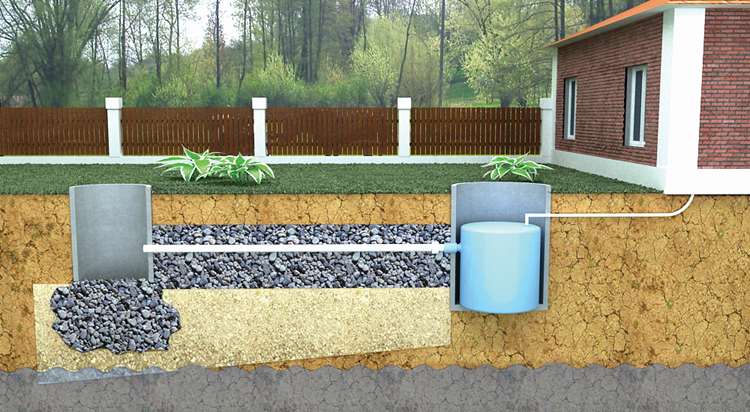 installation of a drainage and cleaning system
installation of a drainage and cleaning system If septic tanks are used
Septic tanks, which provide mechanical cleaning wastewater have their own advantages and disadvantages. Based on the reviews of the owners of septic tanks, it is worth highlighting their advantages:
- the installation works without electricity consumption;
- practically no equipment maintenance is required;
- the system is able to work continuously throughout the year;
- if necessary, you can take breaks in work.
Each installation or equipment has not only advantages, but also disadvantages, which should also be taken into account, in particular this applies to:
- the occurrence of an unpleasant odor;
- use of a large plot of land for the construction and laying of a sewer system;
- the need to maintain the structure using special equipment;
- suitable geological conditions. Septic tanks of simple structures are recommended to be installed in a site where there is a light type of soil and a low level of groundwater.
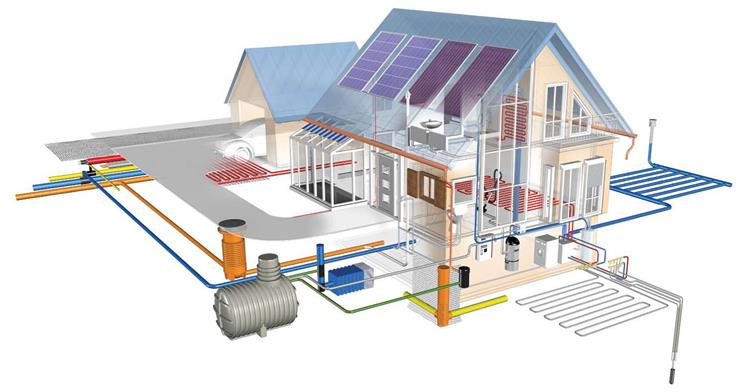 scheme autonomous system sewers
scheme autonomous system sewers Let's pay attention to how it is better to install an autonomous sewage system:
- First you need to determine the volume of the device. For one person, 200 liters of water per day is enough. Thus, drains for three days should be placed in the well;
- after that, you need to choose a suitable place to install a septic device. In carrying out this task, sanitary standards and requirements should be taken into account;
- after that, they dig a hole for mounting a finished septic tank or for constructing wells from concrete rings;
- at the last stage of installation work, pipes are connected and platforms are installed to remove clarified water from the septic tank.
If VOC is used
Not all owners of suburban areas understand what autonomous sewage means, so it is important to say that such installations are able to purify wastewater offline without carrying out private maintenance of the system.
Local treatment plants have the form of an autonomous sewage system in a monoblock design. In this equipment, sewage is cleaned under the influence of biological processes. organic matter decomposed by the action of aerobic microorganisms.
The principle of operation of autonomous sewers is based on forced aeration, it is because of this that fast and high-quality wastewater treatment is carried out.
Despite many important advantages, it is worth noting right away that this equipment is volatile, that is, its operation will be carried out only after voltage is applied.
The advantages include absolutely silent operation, the absence of unpleasant odors and the absence of strict requirements regarding installation, in particular this concerns restrictions on the distance from the residential building.
The standalone station is installed as follows:
- first, a pit is prepared, the size of which will depend on the overall dimensions of the installation;
- a trench is dug up to this pit to bring the pipeline, while a slope of 1-2 cm is made per linear meter of the trench. For the outlet pipe, insulation should be made, so this fact must be taken into account;
- a station is installed in the prepared pit, to which the inlet and outlet pipelines are connected;
- at the last stage of work, you need to supply electricity and connect it according to the scheme, which is indicated in the instructions for the VOC.
Summing up, it is worth saying that an autonomous sewer system is quite complex, so it is better to build it according to a pre-prepared project. In order to choose best installation or design, you need to read the reviews of the owners and the recommendations of specialists. It is also important to pay attention to the technical characteristics of a particular unit.
A private house for many people looks much more attractive than an ordinary city apartment. In it, you can achieve much greater comfort and independence, get real freedom. However, in order to make this possible, you should take care of the arrangement of engineering systems that allow you to achieve a high level of comfort. First of all, it is the water supply and sewerage system, which needs to be given priority.
Of all the engineering systems of a private house, it is the arrangement of an autonomous sewage system that is one of the most difficult, time-consuming and costly tasks. Therefore, its solution is best entrusted to professionals with experience, who not only mount everything efficiently and quickly, but also select equipment that is optimal in terms of cost, capabilities and operating costs.
The cost of this engineering system is determined by a number of factors and is quite high. An attempt to save on the arrangement of an autonomous sewage system often leads to the fact that it starts to work inefficiently, requires frequent maintenance, and, in the end, home owners are faced with the need to modernize or completely replace it.
 Therefore, when you need an autonomous sewage system in a private house, contact our Moskomplekt company for help, whose specialists will competently select the best option based on their experience and install the system with high quality. To understand what makes up the total cost of arranging a sewer system in a private house, all its components should be considered separately:
Therefore, when you need an autonomous sewage system in a private house, contact our Moskomplekt company for help, whose specialists will competently select the best option based on their experience and install the system with high quality. To understand what makes up the total cost of arranging a sewer system in a private house, all its components should be considered separately:
- Internal sewer wiring. This is a system of pipes that drain drains from such plumbing fixtures in a private house as sinks, washbasins, showers, bathtubs, washing and dishwashers, toilets. The whole system joins the common sewer pipe a house, which, as a rule, is brought out under the foundation at a level of half a meter or lower from the ground level to prevent it from freezing in winter.
- Systems for collecting and treating sewage water coming from a private house. It is better to entrust the specific choice of the type and model of receiving and treatment systems to the specialists to whom you entrust the arrangement of the sewerage system. As a rule, for private houses, the best option is to install an automatic sewer station or a flow-type septic tank with a soil aftertreatment system.
- Systems for receiving treated wastewater, which can be organized in the form of an aeration field, drainage wells or a storage tank for collecting technical water, depending on the type of septic tank chosen and the quality of its treatment.
- External underground utilities that connect the elements of the sewer system and are laid in the ground below the depth of its freezing.
In some cases it is also possible to use pumping equipment, which ensures the transportation of wastewater between treatment sites or the discharge of treated water into the gutter, if the landscape features do not allow gravity to transport wastewater.
Factors influencing the choice of type of treatment plant
In addition, when an autonomous sewer is installed, the total costs include the cost of earthworks, the volume and complexity of which depend both on the equipment chosen and on the nature of the soil on the site. At the same time, the key factor determining the total cost of the sewer system is the choice of type and model. treatment facilities, which is determined depending on:
- The nature of living in the house;
- The number of people permanently residing in the house and the number of guests who may be in it for a certain time;
- The volume of the maximum volley discharge of water;
- Number and type of plumbing fixtures installed;
- Features of the area around the house.
Obviously, only professional assistance in solving the issue of arranging an autonomous sewer will allow you to get an effective system that works without failures and requires minimal costs for its maintenance and maintenance in good working order.
How much does an autonomous sewage system cost for a private house
Given the above list of parameters that have an impact on the final cost of arranging the system, it is simply impossible to talk about fixed prices for the creation of an autonomous sewage system. When you apply for the service of sewerage equipment for a private house to the Moskomplekt company, the features of the object are first studied, then a project is developed and an estimate is calculated. Only after the calculation of the estimate, our specialists will be ready to announce the cost of the project.
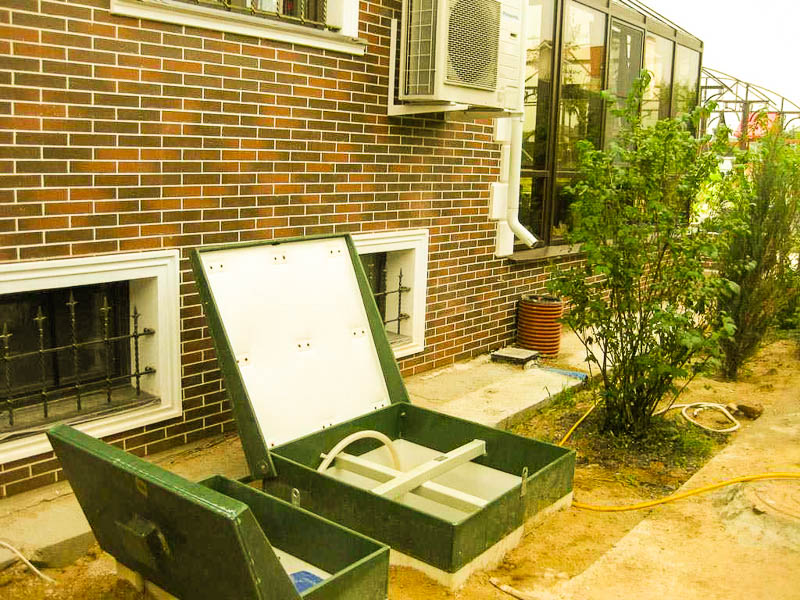 However, for a guideline, we can give the average values of the amount that the arrangement of the sewer system costs. Moreover, these values \u200b\u200bmay differ both up and down from the actual amount calculated according to the estimate of a particular project, according to which an autonomous sewage system is being built.
However, for a guideline, we can give the average values of the amount that the arrangement of the sewer system costs. Moreover, these values \u200b\u200bmay differ both up and down from the actual amount calculated according to the estimate of a particular project, according to which an autonomous sewage system is being built.
When you need an autonomous sewage system for your private home, contact the Moskomplekt company, whose experience of specialists will ensure the competent selection of the system, its design and installation. In addition, you will receive the best prices for services and equipment, thanks to our long-term partnerships with suppliers of reliable systems and components for autonomous sewage systems.
Today it is almost impossible to meet a house with street toilets traditional in the past, because most of the owners of private houses try first of all to organize an autonomous sewage system that would provide them with comfortable living. Autonomous sewerage allows not only not to think about where, how and when to dump waste, but also helps to neutralize them, creating a healthy and clean atmosphere around the house. But before starting to develop a project for a future sewer system, you need to clearly determine for yourself how much wastewater will be drained into it in order to avoid problems in the future.
Of course, any sewage system, autonomous or not, always has its own characteristics. It is impossible to find two identical. That is why it is possible to classify them endlessly. However, there are still some points that allow us to divide sewer systems into several types.
- Depending on electricity, sewer systems are:
- A volatile autonomous sewer system is characterized by the fact that it is small in size, which allows it to be placed even in the smallest area. Thanks to the pump (compressor), all processes in it proceed quite quickly. It is the presence of a pump that makes such systems dependent on electricity. In addition, in addition to periodic cleaning, this type of sewer requires quarterly maintenance, which makes them quite expensive.
- A non-volatile sewage system is absolutely independent of anything (well, except for a person, of course) in which all processes take place independently, that is, by gravity. Naturally, cleaning and filtration, in this case, last much longer, and the dimensions of such a system are much larger.
2. By type of construction:
- cesspool
- structure consisting of overflow wells
- autonomous sewage system with bio-cleaning function
Cesspool and its device
The simplest type of sewage is the classic cesspool, which has been successfully used for several centuries not only in Russia, but also in other countries. This type of sewage, of course, has undergone significant changes that have only benefited him.
Before starting construction, you should choose a place for a cesspool, you just need to take into account that it is possible that some of the water will still seep into the ground and further into groundwater. Therefore, be sure to find out what is the depth of groundwater in your chosen place.
Important: if the depth of groundwater is less than 2 meters, it is impossible to build a cesspool in this place.
If there is a sump on the well site, it is advisable to place it at a decent distance - ideally at least 30 meters. If the possibilities of your site are not so extensive, then place the sewer diagonally in order to avoid accidental seepage of harmful effluents into clean drinking water.
Calculation of the volume and depth of the cesspool
Any autonomous sewerage of a private house, including a cesspool, must begin with calculations. For a small family of three to four people, the most optimal volume (given that there are about 250 liters of water per person per day) will be a volume of 1.5 cubic meters. meters.
In any case, even if the volume of the cesspool is smaller, periodic cleaning will be necessary, that is, calling a sewage truck. Consider also the presence in the house of automatic washing machine and dishwashers (if any, of course), which also contribute to a fairly quick filling of the sump.
Another factor that can determine the size of the sewer is the design of the cesspool itself. If it has an additional absorbing hole, then part of the drains will go into the soil, which will significantly "increase" its size. With small volumes, such a sewage system will not harm either man or nature.
Such an absorbing pit is usually made of small sizes, since the function of accumulating sewer masses, in this case, disappears. However, the soil can cope with only a small amount of waste and decomposition products, while infiltration of large volumes, it first poisons itself, and then spreads this effect to the surrounding space and even people. You can, of course, use a peat powder closet (peat cushion that is laid on the bottom of the pit), which will eliminate the harmful fecal component of wastewater. In this case, in addition to cleaning the drains, you will get excellent compost for the beds.
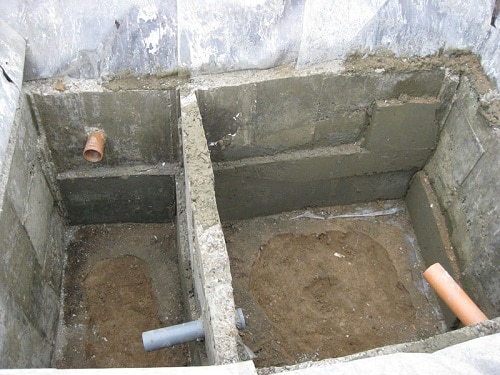
Autonomous sewerage device (cesspool)
The construction of a simple sewer
The device of an autonomous sewage system, in particular a cesspool, is simple, but it can take you a lot of time and effort, unless, of course, you decide to drive heavy equipment to the site.
- First stage of work- pipe laying. There is nothing complicated here, the main condition that must be observed is to adhere to a constant slope of 3-5 degrees so that the water drains without problems and there is no silting. Just keep in mind that the longer the pipes, the greater the angle of inclination should be.
- Second stage of work. The walls of the pit are carefully aligned, and the bottom is made with a slight slope to the side, where you intend to make a hatch for pumping wastewater.
Usually a hole is dug in a square or rectangular shape, less often round, but you will have to decide on the dimensions yourself.
The bottom of the pit is lined with sand with a layer of about 15 cm. Concrete is poured over such a pillow with a thickness no less than a layer of sand. After the concrete has set, it is necessary to make a sand-cement screed of 4 cm on it. If possible, you can not bother and simply lay a finished concrete slab on the bottom of the dug hole.
The walls of the pit can be laid out with burnt bricks or metal or concrete rings can be installed in it, since today you can buy whatever your heart desires.
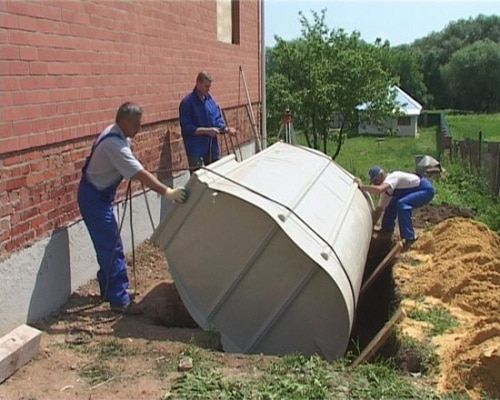
Installation of a septic tank for autonomous sewage

- Third stage of work. After all the measures for the internal arrangement of the cesspool are completed, you can proceed to the construction of floors. They must be made of very durable and reliable material, for example, thick sleepers or any reinforced concrete structures.
From the sides, the pit should overlap by at least 40-50 cm, and the drain pumping hatch should have dimensions of approximately 70 * 70 cm.
Autonomous sewerage country house almost ready, it remains only to finish what we started. The finished floor must be properly isolated from water. To do this, you need to use any waterproofing material, for example, roofing material, which is laid on top of the slabs or sleepers. Soil, sand, slag (in general, whatever you want) are poured over the roofing material with a layer of about 40 cm.
Be sure to make a lid that will reliably protect you from unpleasant odors. It is desirable that it be double - one at ground level, and the second - at the level of the ceiling. In winter, the space between the two covers is covered with slag, polystyrene foam, straw or any other insulation, thereby protecting drains from freezing, and you from wasting money, time and effort.
If autonomous sewerage with your own hands is not a problem for you and you are ready for the upcoming work, then a cesspool is the easiest and easiest way. You can build such a system in a week, and most of the time you will spend on digging the hole itself.
Autonomous sewer system based on the principle of overflow wells
Such a system consists of two wells: the first serves as a sump for solid waste, and the second as an infiltrator.
The first well is made of concrete or metal rings with a cement bottom, or a ready-made plastic septic tank is installed on the bottom of the pit. The second well does not have a bottom at all, but is lined with rubble or gravel. The liquid, cleared of solid elements, enters the absorbing well through the pipe, where it is absorbed into the soil.
During the operation of such an autonomous sewer, it is necessary to pump out sludge from the first well once a quarter, otherwise stagnation will form. But you can reduce the number of calls to the sewage truck to once every six months, if you use special biological products that break down solid fractions.
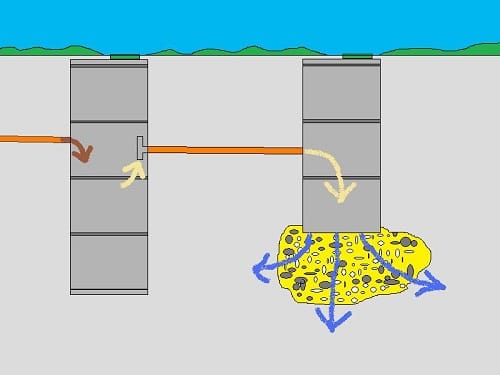
overflow wells
The use of a system of overflow wells is possible only for small country houses with a daily waste volume of not more than 1500 liters. Large cottages and mansions should be equipped with other facilities, for example, a sewage system with a bio-cleaning function.
Independent sewerage with bio-cleaning function
Autonomous sewage systems with their own bio-treatment station are a septic tank, which includes a large storage tank and a filtration field that collects all pollution and waste. Such sewerage is currently considered the most modern and efficient, but its cost is much higher than the first two systems described above.

Thanks to the biotreatment station, which can be of a chemical, biological or mechanical nature, wastewater is purified and sediment accumulates.
- The chemical method of wastewater treatment is based on the use of a variety of chemical reagents that change the structure of the liquid that has entered the septic tank into a solid state. These elements eventually settle to the bottom of the tank. This technology, although suitable for a country house, is still more common in large industrial enterprises, where dosages of chemicals are strictly observed.
- A sewer system with mechanical self-cleaning can be found in dachas and suburban areas with small volumes of wastewater, for example, if the owner of such a house does not live there permanently, but comes for the weekend. This method of device does not require high financial costs, you only need to periodically replace the crushed stone in sewers and occasionally clean the septic tank from solid sediments.
- biological method sewer cleaning is based on the use of bacteria that decompose organic and inorganic waste, turning them into sludge, water and carbon dioxide. Such a system can be additionally equipped with a block with a frame-replacement filter, a UV disinfection mechanism and a drainage pump.
Any autonomous sewage system, reviews of which you can find in large numbers on the Internet, requires not only careful maintenance and control, but, above all, high-quality assembly. Therefore, be sure to develop a diagram of the future sewer system, sketch out a plan and think about where and how it will be located.
Such an approach to work will certainly bring only positive results.
Creating a modern level of comfort in suburban housing of any type necessarily involves the installation of a number of engineering systems, and one of the key among them is autonomous sewage. It is its arrangement that should be given priority, since the installation of autonomous sewerage systems is associated with certain, rather voluminous earthworks. Naturally, it is better to complete them immediately before you start landscaping the territory on your personal plot.
In fact, if we are talking about the construction of a new house, summer house or cottage, the installation of an autonomous sewage system should be carried out immediately after the construction of the house is completed, simultaneously with the installation of the internal part of the engineering systems.
Of course, if the house was built a long time ago and you just need to increase the level of living comfort in it, the sewerage system can be installed later, the market for modern autonomous sewage systems makes it possible to do this on any site, with any features and number of people living in the house. The main thing is to entrust the selection and installation of the sewerage system to experienced professionals so that its cost, fixed costs during the period of use of the system and performance characteristics were optimal.
The modern market of technical solutions allows you to choose autonomous sewers with any technical specifications, capable of solving the problem of processing domestic wastewater in the required volume to a given degree of purification. In addition to ready-made solutions, it is also possible to use technologies for the construction of local treatment facilities, which were used before the widespread use of treatment plants and ready-made septic tanks. In any case, the choice of the type and parameters of an autonomous sewage system should be made by an experienced specialist, taking into account all the features of the object.
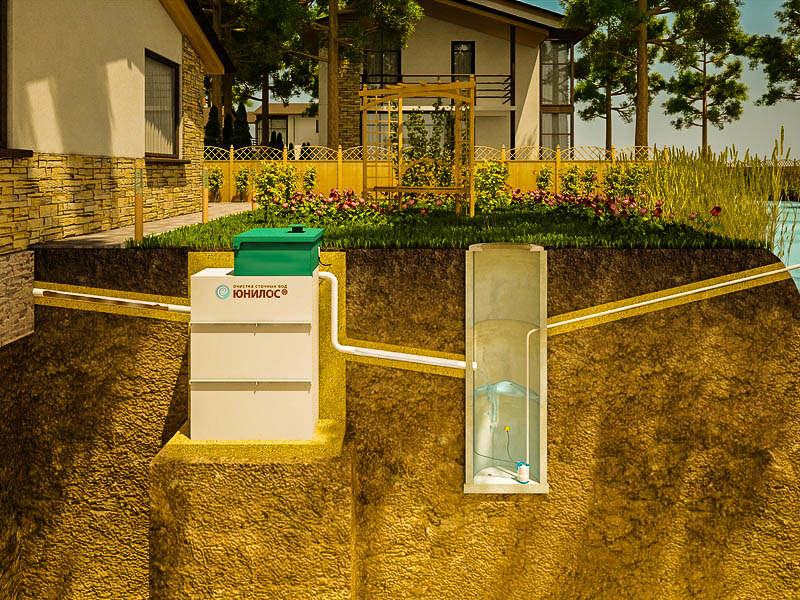 The ideal option for arranging this engineering system can be called the case when an autonomous sewage system is designed and installed as part of a complex of works for the construction of a turnkey house. In this case, its parameters will be optimal, and the cost will be minimal due to the complex order and the opportunity to get a significant discount.
The ideal option for arranging this engineering system can be called the case when an autonomous sewage system is designed and installed as part of a complex of works for the construction of a turnkey house. In this case, its parameters will be optimal, and the cost will be minimal due to the complex order and the opportunity to get a significant discount.
In any case, it is advisable to know which autonomous sewage system suits you best, so as not to make a mistake in choosing and get the optimal ratio of costs for arranging and maintaining the system.
Today, for private housing, country houses and cottages, various types of autonomous sewers are used, each of which has its own characteristics, advantages and disadvantages, so a few words need to be said about each of them.
The simplest autonomous sewage system based on a cesspool
This is really the simplest and most primitive system for collecting domestic waste water from a house to a cesspool. Such a pit is a container, usually of a sealed type, to prevent contamination of the site. The container can be made independently, for example, it can be used as:
- a pit of the required volume, lined with bricks or concreted;
- a large barrel buried in the ground;
- ready-made special container, as a rule, plastic.
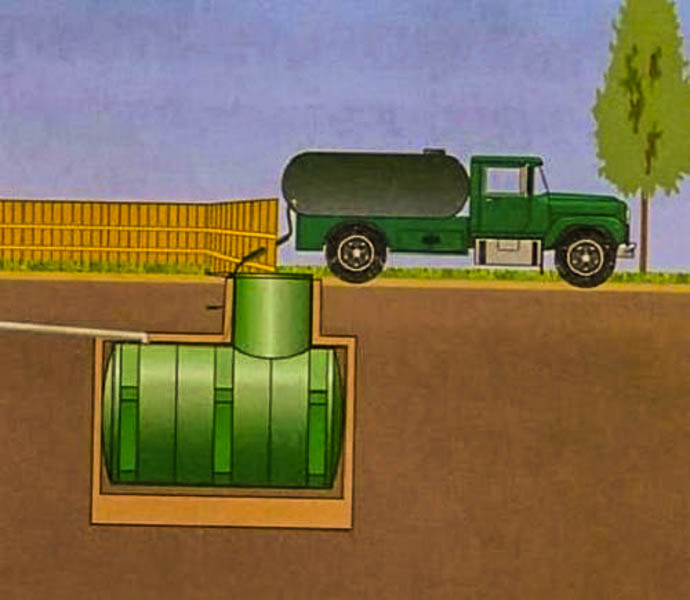 Whatever the arrangement, such a system will require the owners of the house to periodically maintain it, which consists in pumping out sewage with an silo pump. You will have to pay regularly for its services, so the cost of maintaining such systems is quite high with low costs for its equipment. In addition, a cesspool can become a source of unpleasant odors on the site, and also imposes certain requirements on removing it from the house and other buildings.
Whatever the arrangement, such a system will require the owners of the house to periodically maintain it, which consists in pumping out sewage with an silo pump. You will have to pay regularly for its services, so the cost of maintaining such systems is quite high with low costs for its equipment. In addition, a cesspool can become a source of unpleasant odors on the site, and also imposes certain requirements on removing it from the house and other buildings.
Therefore, this option for solving the problem of collecting sewage from the house is usually resorted to in dachas, where there are infrequently 1-2 people. Also, such a solution is sometimes used as a temporary option, followed by a planned rework of the system.
Homemade flow septic tank
Such an autonomous sewage system used to be quite popular. It is still used today, but much less often due to difficulties in maintenance and repair, as well as a low degree of wastewater treatment. It is made from three or more containers connected in series, as a rule, from concrete rings, between which sewage flows by gravity, gradually settling and being cleaned by bacteria. From the last tank, effluents are directed to a drainage field or to a system of wells.
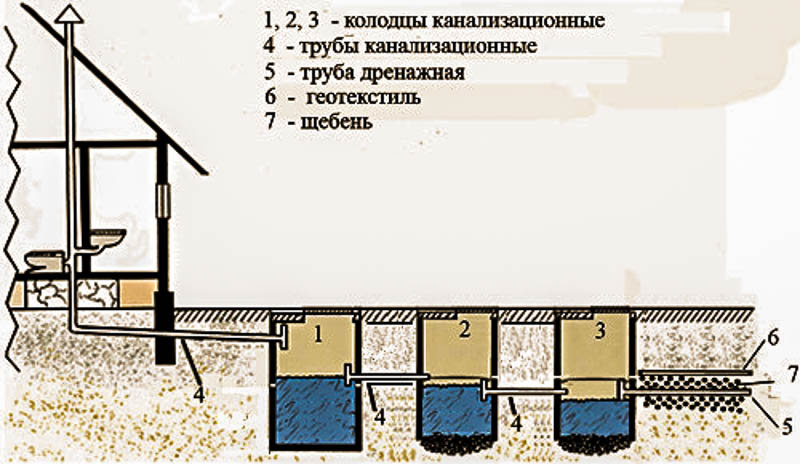 The main disadvantage of arranging such a system is the high labor intensity, difficulty in repair, as well as labor-intensive maintenance, which consists in the periodic cleaning of all containers.
The main disadvantage of arranging such a system is the high labor intensity, difficulty in repair, as well as labor-intensive maintenance, which consists in the periodic cleaning of all containers.
Non-volatile ready-made septic tank
This autonomous sewage system is similar in principle to a home-made septic tank, but the use of one multi-chamber tank makes it more technologically advanced both in installation and maintenance. This container, as a rule, is made of durable plastic with a long service life, so it does not require repair for a sufficiently long period. A ready-made aeration field or infiltrate is connected to the septic tank, with the help of which the sewage is cleaned up with soil.
 Depending on the estimated load on the septic tank, the volume of the tank and the number of infiltrates are selected in order to cope with the maximum estimated discharge of wastewater without disruption. Such septic tanks are completely non-volatile, however, they require a lot of space on the site and a significant amount of excavation for their installation.
Depending on the estimated load on the septic tank, the volume of the tank and the number of infiltrates are selected in order to cope with the maximum estimated discharge of wastewater without disruption. Such septic tanks are completely non-volatile, however, they require a lot of space on the site and a significant amount of excavation for their installation.
Autonomous treatment plants
Autonomous sewerage based on an autonomous wastewater treatment plant is today the leader in installation in country houses especially where they live permanently. The fully automated treatment process to the point where the purified water can be discharged into a gutter or used for industrial purposes with simple periodic maintenance makes these systems the optimal choice in most cases.
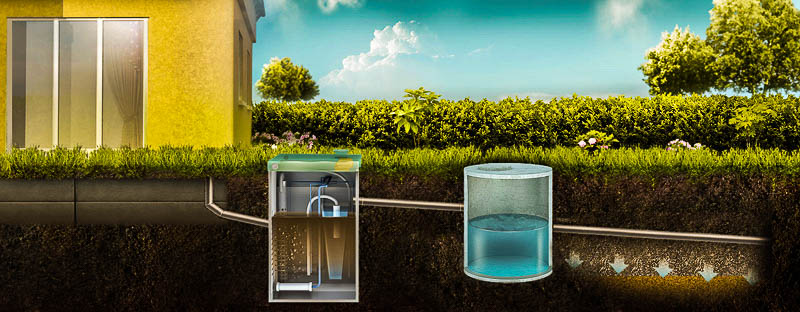 The only drawback of autonomous sewers of this type is the need for normal functioning of the power supply, which ensures the operation of compressors for aeration and transfer of wastewater between working chambers. Therefore, such stations are recommended to be installed only where there are no significant interruptions in the power supply or to provide a backup power system.
The only drawback of autonomous sewers of this type is the need for normal functioning of the power supply, which ensures the operation of compressors for aeration and transfer of wastewater between working chambers. Therefore, such stations are recommended to be installed only where there are no significant interruptions in the power supply or to provide a backup power system.
What should be considered for the competent choice of autonomous sewage
In order for this engineering system to work properly, cope with its task and require minimal attention for maintenance, you should carefully analyze the possible options and choose the most optimal one.
Firstly, the average, minimum and peak maximum load on the sewerage system is determined based on the number of people living in the house, their possible increase due to guests or relatives who may live with you for some time.
You should also take into account the costs of designing the system, the purchase of the treatment facilities themselves, their installation and maintenance, which can be carried out independently or entrusted to a specialized company.
To whom to entrust the arrangement of an autonomous sewage system
When you need an autonomous sewage system in a private house, in a country house or in a cottage, please contact our Moskomplekt company. We provide autonomous sewage services both separately and as part of a comprehensive service for the construction of turnkey houses with the installation of engineering systems.
 Our specialists will survey the site, study the features of your residence and your needs for installing plumbing fixtures, the frequency of their use, and then select the best type of sewerage system and its brand. We will spend everything necessary work installation of the system, its connection to the communications of the house, we will launch and conduct training. Also, our company "Moskomplekt" can take over all the work related to the maintenance of the system and its repair at the end of the warranty period.
Our specialists will survey the site, study the features of your residence and your needs for installing plumbing fixtures, the frequency of their use, and then select the best type of sewerage system and its brand. We will spend everything necessary work installation of the system, its connection to the communications of the house, we will launch and conduct training. Also, our company "Moskomplekt" can take over all the work related to the maintenance of the system and its repair at the end of the warranty period.
How much does it cost to equip an autonomous sewer
The cost of designing, installing and launching an autonomous sewage system for any object is determined by its type, model, features of the site where it will be installed.
Moskomplekt LLC has partnership agreements with manufacturers of most brands of modern autonomous sewer systems, so the purchase of equipment and installation supervision when ordering system components from us is cheaper in total. In addition, we use our own transport and special equipment, which allows us to reduce the cost of preparatory work and installation of treatment equipment.
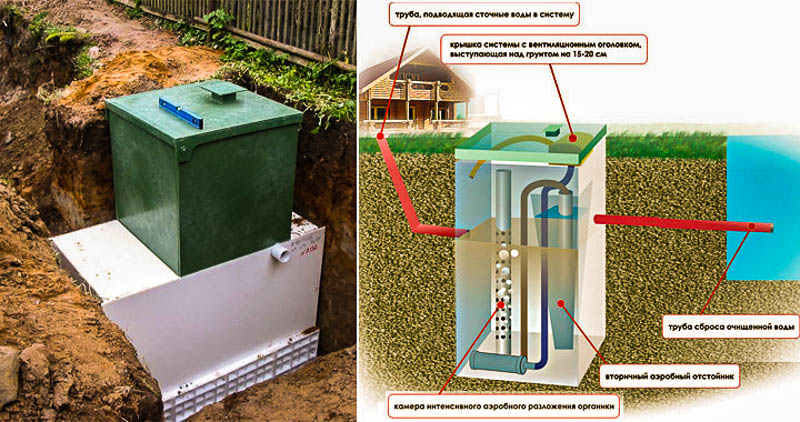 The exact price for the arrangement of an autonomous sewer system is determined after the development of the project and the calculation of estimates for work and materials. You can roughly estimate how much it will cost to install an autonomous sewer station using the cost table for typical work carried out during its installation.
The exact price for the arrangement of an autonomous sewer system is determined after the development of the project and the calculation of estimates for work and materials. You can roughly estimate how much it will cost to install an autonomous sewer station using the cost table for typical work carried out during its installation.
The cost of work performed during the installation of an autonomous sewer station
| Name of works | Units | Amount, rub. for a unit |
| Installation of an autonomous sewer station | PCS | from 20000 rub. |
| Laying a sewer pipe from the house to the septic tank | p.m. | from 800 rub. |
| Laying pipelines in the house | PCS | from 900 rub. |
| Installation of plumbing fixtures | PCS | from 1650 rub. |
| Making a hole for a pipe ∅ 110 mm in wood | PCS | from 1000 rub. |
| Making a hole for a pipe ∅ 110 mm in concrete | PCS | from 2900 rub. |
Please note that after signing the contract, we do not have the right to increase the cost of work calculated according to the estimate. Please contact us when you need the design and installation of an autonomous sewage system. The minimum terms, competitive price for the Moscow region, long-term guarantee for the system will leave only positive impressions from cooperation with the Moskomplekt company.







